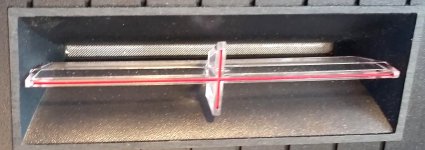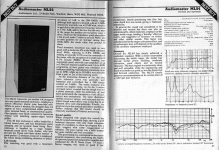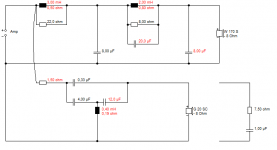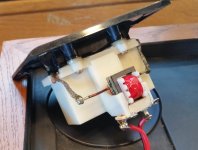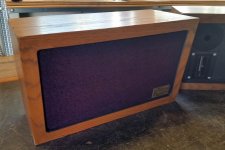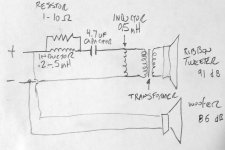Not much to see there, Steve.Can we get more detail on this item? I can't read it properly.
2,500 -30,000Hz; 91dB; 8 ohm; 35W using a 1.8uF cap (11,000Hz); maximum cap recommendation 6.8uF (3,000Hz).
Initial tests with just a single 4.2 uF capacitor (about 4,700 Hz) vastly improve the top end on the speaker.
Realistic indicated that this tweeter could be run from a single capacitor, but increasing the capacitor value decreases the power handling of the tweeter.
Rather than a single 4.2 uF capacitor, the safer option would be a 2nd order LC filter which could be employed on the tweeter alone. This will give more protection to the tweeter. I suggest a 4,000Hz crossover frequency, but Steve will keep you right!
If you're up for some simple experimentation, then retain the 4.2uF cap and wire a 0.5mH inductor across the terminals of the tweeter assembly (across the input terminals of the tweeter's transformer). This will give a crossover frequency of around 3500Hz, but with a steep 12dB per octave slope to protect the tweeter.
I wouldn't mess around with the tweeter construction at this stage. It won't make much difference and might wreck the tweeter.
More important things to do. This is an Audax HD20B25H 8" bass it seems.
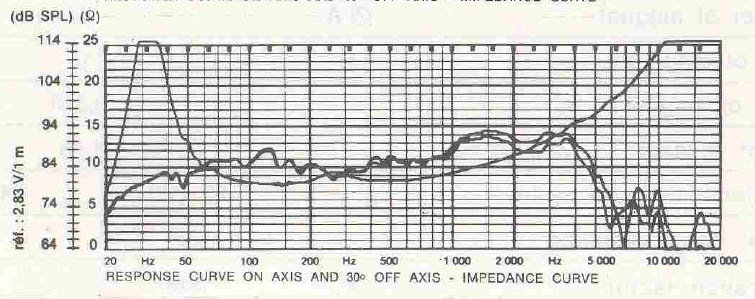
I've just hit paydirt on this:
Are these speakers worth refurbing?
Some of the images are now broken, but I had a stab at the crossover for the Audiomaster MLS4 years back in that thread. I was working with amateurs there, so can't say much for coil values, and I'd have to rerun a sim to see if it works, but I still have some of the images. I think I could knock that into shape. Looks like a 1.5kHz LCR notch needed. Maybe impedance correction, which is going to be around 7.5R plus 15uF.
The great Robin Marshall worked with Audiomaster and Tangent, IIRC. I think we could dig up a bass filter for this Audax HD20B25H driver somewhere. Or synthesize one. The tweeter will be relatively easy, after that. I must sleep on this.
More important things to do. This is an Audax HD20B25H 8" bass it seems.
I've just hit paydirt on this:
Are these speakers worth refurbing?
Some of the images are now broken, but I had a stab at the crossover for the Audiomaster MLS4 years back in that thread. I was working with amateurs there, so can't say much for coil values, and I'd have to rerun a sim to see if it works, but I still have some of the images. I think I could knock that into shape. Looks like a 1.5kHz LCR notch needed. Maybe impedance correction, which is going to be around 7.5R plus 15uF.
The great Robin Marshall worked with Audiomaster and Tangent, IIRC. I think we could dig up a bass filter for this Audax HD20B25H driver somewhere. Or synthesize one. The tweeter will be relatively easy, after that. I must sleep on this.
Attachments
It's not so much a matter of hearing a difference as adequately protecting the tweeter from low frequencies.Galu: I tried that with a 0.4mH inductor, but I could not hear any difference with or without the inductot.
As Steve says, do not make any physical modifications to the tweeter as these would probably be detrimental and irreversible!
system7: You're starting to lose me in complexity, I am a simple man. The speakers cost me only slightly more than the Polydax/Audax woofers might fetch at auction, and it appears these ribbons are not highly regarded. The crossovers you propose may exceed the value of price paid and I'm not sure it would yield audio nirvana. Perhaps I keep my Celestion Ditton 100's and admit I'm over my head. (Dittons recapped. Lovely).
Continued thanks to all!
Continued thanks to all!
As I illustrated in post #10, the red thing on the tweeter is not an inductor, but is a transformer. I won't go into what it does unless you ask!Galu: The tweeters appear to have an inductor installed already, so is the second suggested inductor extra insurance?
The tweeter is robust enough to run with the 4.2uF capacitor alone. However, for extra protection, I recommend a 0.5mH inductor to be included (not a 0.4mH one). You simply connect the inductor straight across the bottom two terminals of the red transformer in your photograph. Do not disconnect the wires already soldered to the transformer.
Installing a full crossover network, like the one Steve is suggesting, may be a step too far considering your limited knowledge of the subject.
Stick with the 4.2uF capacitor - maybe add the 0.5mH inductor - then sit back and enjoy the music!
Yep that tweeter is robust. Not only thick foil BUT its not a floppy free swing ribbon, its firmly held in place by a rubbery suspension all the way around the foil "ribbon". This is why you can get away with a single cap crossover.
That said I would leave the inductor across tweet as Galu says. Its not changing sound and it gives a little bit of insurance.
Sounds like you have gotten rid of the resistor/ 2.4 uf cap part and it gave desirable result. That resistor /cap part was pulling down the low end response of the tweeter wich was already likley too low.
I like the easy "fix"
From here If the lower treble is better and you have acceptable clarity then its possible that the high treble ( above 7 khz) is a bit "Hot" overall.
If so its a simple fix by doing exactly opposite of the original cap/resistor part you removed.
Instead of the cap/resistor section you removed you can install in same place a small inductor ( probably around 0.2-.5 mH), in parallel with resistors( about 1-10 ohms) This becomes a tone control for the upper treble region ,and this one mod makes it easy to tailor the overall voicing of the speaker. Very small changes in the resistors in this section can make the mid range sound more convincing.
Larger inductor and / or larger resistors will lower the volume of the upper treble region. Play, its simple and cheap.
That said I would leave the inductor across tweet as Galu says. Its not changing sound and it gives a little bit of insurance.
Sounds like you have gotten rid of the resistor/ 2.4 uf cap part and it gave desirable result. That resistor /cap part was pulling down the low end response of the tweeter wich was already likley too low.
I like the easy "fix"
From here If the lower treble is better and you have acceptable clarity then its possible that the high treble ( above 7 khz) is a bit "Hot" overall.
If so its a simple fix by doing exactly opposite of the original cap/resistor part you removed.
Instead of the cap/resistor section you removed you can install in same place a small inductor ( probably around 0.2-.5 mH), in parallel with resistors( about 1-10 ohms) This becomes a tone control for the upper treble region ,and this one mod makes it easy to tailor the overall voicing of the speaker. Very small changes in the resistors in this section can make the mid range sound more convincing.
Larger inductor and / or larger resistors will lower the volume of the upper treble region. Play, its simple and cheap.
Last edited:
@ turk 182:
Look at the photograph in post #15, where the cabinet is shown orientated horizontally. This results in the major axis of the tweeter being orientated vertically. Maybe this is the way round the speaker is intended to be used.
Perhaps the OP will clarify the matter for us.
Look at the photograph in post #15, where the cabinet is shown orientated horizontally. This results in the major axis of the tweeter being orientated vertically. Maybe this is the way round the speaker is intended to be used.
Perhaps the OP will clarify the matter for us.
Yup, in over my head, I admit to limited knowledge. I will experiment with caps in the 4.7 (4,200Hz) to 5.6 (3,600) range, and I will order some 0.5mH inductors from Parts Express (are air core preferred over solid core?). I will get this done and keep it simple for a while,
lowmass, see the attached schematic, is this how you described it? Which resistance direction increases midrange, higher or lower resistance? What rating on the resistors, 2 watt okay? Would a 10 ohm rheostat work here?
As regards ribbon orientation, the speakers where designed as monitors to be hung on a wall left and right, horizontally, indeed firing downward. Note the alignment of the badges on the grille cloth. If I were to use them vertically, I'd have to rotate the tweeter 90 degrees.
Continued thanks!
lowmass, see the attached schematic, is this how you described it? Which resistance direction increases midrange, higher or lower resistance? What rating on the resistors, 2 watt okay? Would a 10 ohm rheostat work here?
As regards ribbon orientation, the speakers where designed as monitors to be hung on a wall left and right, horizontally, indeed firing downward. Note the alignment of the badges on the grille cloth. If I were to use them vertically, I'd have to rotate the tweeter 90 degrees.
Continued thanks!
Attachments
When an inductor is included with the capacitor, the crossover frequency is lowered and the effectiveness of the filter increases.Yup, in over my head, I admit to limited knowledge. I will experiment with caps in the 4.7 (4,200Hz) to 5.6 (3,600) range, and I will order some 0.5mH inductors from Parts Express (are air core preferred over solid core?). I will get this done and keep it simple for a while.
The capacitor and inductor values must be calculated to match each other e.g. a 4.7uF capacitor, when matched with a 0.6mH inductor, results in a crossover frequency of 3000Hz.
Use air cored inductors and polypropylene caps.
The 'Second Order 2-Way' Crossover Calculator on the site below will allow you to experiment with different component values. Choose 'Butterworth', enter 8 ohm for the two impedances and play around with the crossover frequency to see which capacitor and inductor values pop out. P.S. Ignore the 'Low Pass' section.
ERSE - Crossover Calculator - Second Order 2 Way
I should add that the capacitor and inductor values don't have to be spot on. The actual physical values need only be within plus or minus 10% of the calculated values (even 20% is not too bad!).
e.g. If you insert a frequency of 3500Hz into the crossover calculator, it comes up with C = 4.018uF and L = 0.515mH. The 4.2uF capacitor you already have will therefore work fine with a standard 0.5mH inductor from Parts Express, as both of their values are within 10% of the calculated values.
e.g. If you insert a frequency of 3500Hz into the crossover calculator, it comes up with C = 4.018uF and L = 0.515mH. The 4.2uF capacitor you already have will therefore work fine with a standard 0.5mH inductor from Parts Express, as both of their values are within 10% of the calculated values.
Last edited:
lowmass, see the attached schematic, is this how you described it? Which resistance direction increases midrange, higher or lower resistance? What rating on the resistors, 2 watt okay? Would a 10 ohm rheostat work here?
Continued thanks!
yes that is right. You may not need it BUT it cheap to try and based on the sensitivity of your woofer that tweeter may be too hot up high.
however this wont "increase mids", it will decrease high treble wich may be needed to get a good balance between mids and treble. That tweeter has a rising response out through high treble region. That inductor/resistor combo can flatten that response out without affecting the lower treble. Getting the right balance between mids/low treble and high treble is a very important part of good sound.
larger value resistors will lower high treble
lower value resistors will allow more high treble
use 10 watt resistors
sometimes when I use this circuit I use a rheostat as you mention to decide on what resistor value I need. In the end I change to resistors. Reostats can have issues
Last edited:
Galu, lowmass, big thanks for all the kind patience and education. I may not find the tweeter is "too hot" as my ears started off fine early on, but after going to arena concerts in Detroit (Blind Faith, The Rolling Stones, Alice Cooper, Johnny Winter, Black Sabbath, David Bowie and the Spiders from Mars, Roxy Music) what's survived years of audio abuse falls prey to the top end loss of aging. All I sought was to get some top end back. Now where was that "Moonage Daydream" cut?
And, I am hoping my SET or 6V6 PP will love the speakers, too.
Thanks again.
MG
Detroit
Dearborn
Hollywood
Manhattan Beach
Newark/Fremont
San Jose
Willow Glen
Morgan Hill
Irvine
(Time to cool my boot heels)
And, I am hoping my SET or 6V6 PP will love the speakers, too.
Thanks again.
MG
Detroit
Dearborn
Hollywood
Manhattan Beach
Newark/Fremont
San Jose
Willow Glen
Morgan Hill
Irvine
(Time to cool my boot heels)
Those tweets do have more top end than you will hear- had one kid that could hear them clear at 21kHz!I may not find the tweeter is "too hot" as my ears started off fine early on, but after going to arena concerts in Detroit (Blind Faith, The Rolling Stones, Alice Cooper, Johnny Winter, Black Sabbath, David Bowie and the Spiders from Mars, Roxy Music) what's survived years of audio abuse falls prey to the top end loss of aging.
Used the surviving one for the top end for a center speaker in the home theater to good effect, sold it with the rest of the system and house..
- Status
- This old topic is closed. If you want to reopen this topic, contact a moderator using the "Report Post" button.
- Home
- Loudspeakers
- Multi-Way
- Ribbon Crossovers: Need help...
